From Habitat magazine - issue 23
Gone is the austere minimalism of recent times as more designers opt for timber.
As an interior material, timber has always had a place. Trends may come and go but timber has a certain feel that's irreplaceable. It has always featured in older character homes but has become a rising star in contemporary interiors too, adding richness and personality to our homes. And protected and enriched with Resene products, it will continue to look great for years to come.
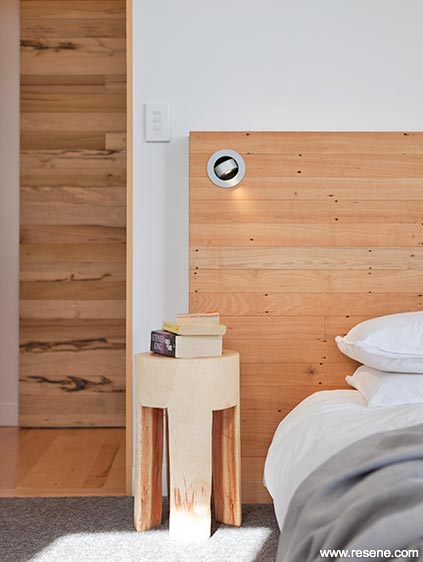
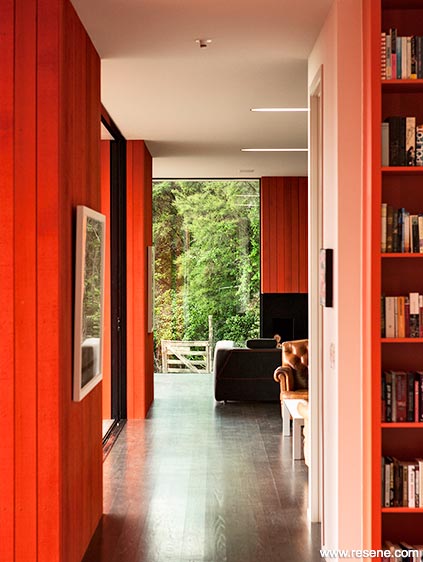
As architect Dave Strachan of SGA says of timber: "As a natural material it has personality – every piece of timber is different. The various timbers reflect their inherent qualities."
Nothing can match timber for its infinite variety of natural markings and grains. "Timber brings colour, texture, life – even a smell. Timbers such as lawson cypress [yellow cedar] have a distinctive smell which almost gets richer over time," says Dave.
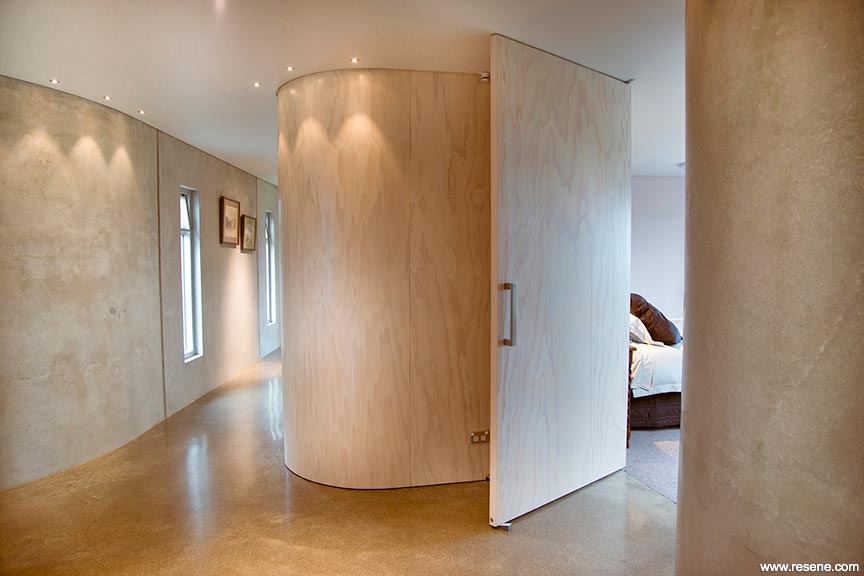
The resurgence of timber in interiors goes hand in glove with the return of an appreciation for craft production over industrial manufacturing. If the budget allows, Dave likes to design complete interior fit-outs using timber – for kitchens, storage solutions including shelving and drawers, beds and so on. "We detail a lot of that furniture. It means, as the architect, we have a good idea of what's going inside the building rather than getting an independent interior designer to come in."
Nicolas Stevens of Stevens Lawson Architects also loves timber, "because it creates an atmosphere of warmth, giving a crafted, elegant look and a certain sensuality." The advantage of timber, he says, is it can be used in so many different ways. "We often use it on the floor, on ceiling linings and walls. We almost always use it in kitchens and on various cabinetry throughout the house."
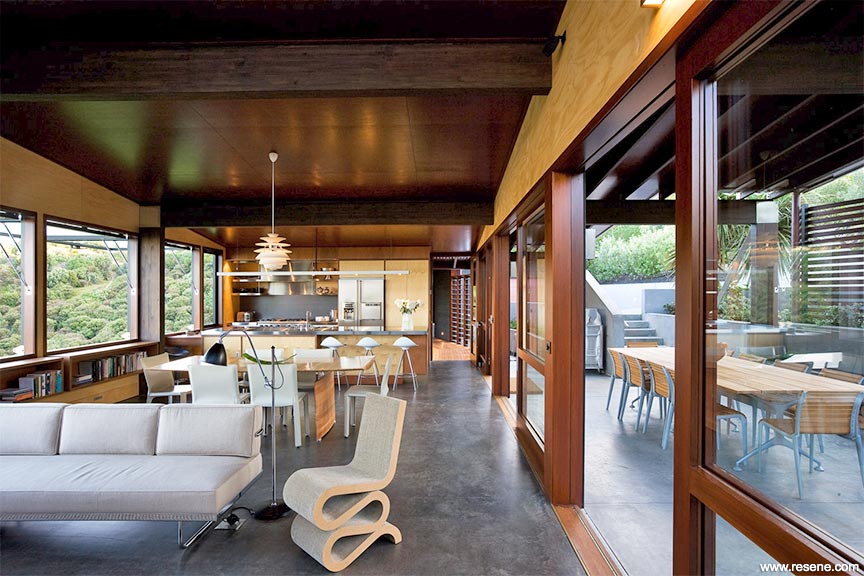
Timber fits with the eco-trend towards all things natural and sustainable, says architect William Giesen of Atelier Workshop. "A lot less energy goes into the fabrication of timber linings rather than typical plasterboard. With timber linings, you don't need to plaster, which is great environmentally."
Sound absorption, he says, is another great quality. "As well as bringing a level of craft to an interior, when using timber inside, you don't end up with hard surfaces everywhere. It makes a room much softer."
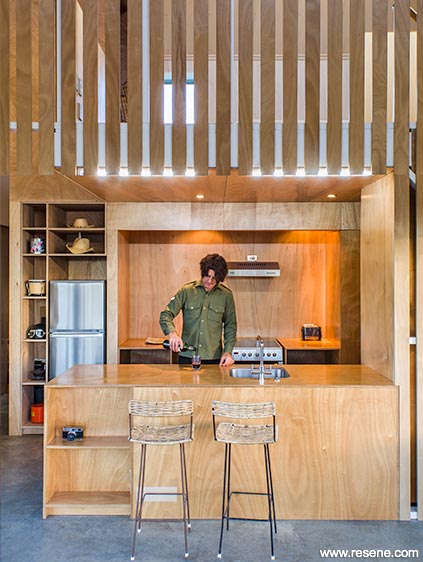
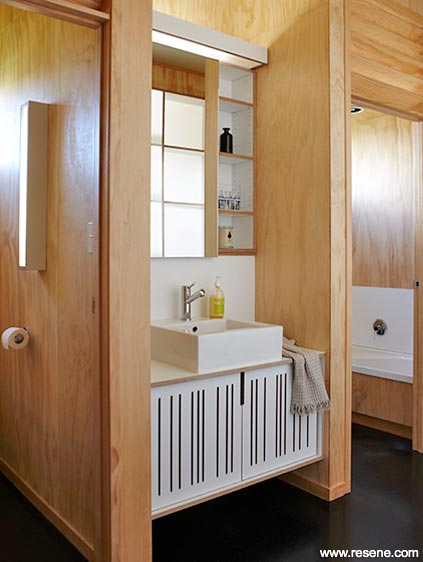
And, of course, wood has good structural qualities, says Giesen. "It performs well, giving flexibility when used as structural bracing. We have done a number of projects where we have exclusively used wood as a wall lining."
Studies also show that timber in buildings influences people's behaviour in a positive way – giving health benefits that mimic spending time outside in nature. Earlier this year, Planet Ark, an Australian environmental not-for-profit organisation, released a report identifying wood as helping to improve a person's emotional state; reducing stress, improving air quality and having the ability to store carbon.
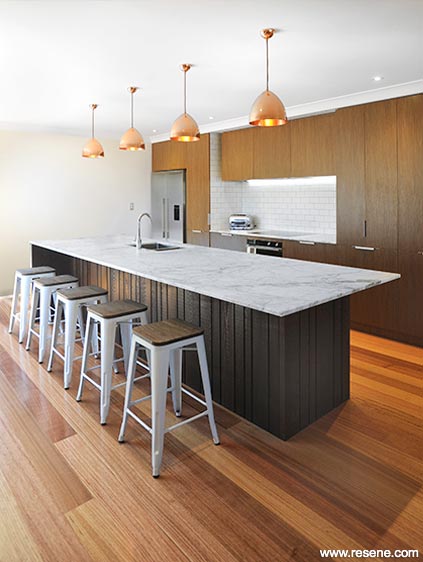
*Timber kitchen
Kitchen designer Liz Kerby of Lizzie & Co uses timber frequently in combination with natural stone, marble, ceramics, leather and paint. She says it's the perfect complement to these other materials. She calls them 'comfort materials', because they soften and enrich interiors, helping to move away from sharp-edged kitchens with their deliberately jarring metallic brightness and industrial-style surfaces.
Timber is hugely versatile when it comes to creating specific kitchen styles, says Liz. It can be used in either a contemporary or traditional way, and is a key element of the current vintage rustic look. She's not afraid to use recycled timbers alongside more refined timbers for contrast and says that recycled timber has a grounded authentic appeal.
Timbers don't have to be solid. In fact, using timber veneers or man-made composite veneers are not only an eco-conscious choice but are also cost effective. There's an extensive range of colours, textures and grains available to go with any look. Says Liz: "They are a stylish alternative to solid wood with a lovely linear detailing you wouldn't get normally."
Nicolas Stevens likes to use band-sawn timber, "which adds a rough texture and gives a lot of character. It tells a story."
When it comes to selecting timbers, it's horses for courses. Hardwoods work best on floors because they endure traffic without being damaged or dented.
Lately Stevens has been using spotted gum, a hard Australian eucalypt for floors, ceilings and cabinetry. "It's a lovely nutty brown colour with a distinctive grain." He also uses cedar for flooring.
*Liz Kerby of Lizzie K & Co used cabinets in the finely grained Wild Pecan from Laminex's Designed Timber Veneers range contrasting with a more rustic cedar beneath the island bench. The kitchen was made by Neo Design and the timbers are protected with Resene Aquaclear.
Previously the domain of building sites and dodgy fences, plywood is big news. Made of thin layers of wood veneer bonded together with adjacent layers of wood grain rotated at right angles, ply is incredibly versatile and inexpensive. It can also be made of many types of timber, from standard pine through to maple, birch and more.
"Plywood is a very elegant product," says Liz. In a recent kitchen design, she used ply as a substrate for an oak veneer, using the exposed ply edge as a feature.
At Atelier, Cecile Bonnifait and William Giesen frequently use plywood in interiors, "because it requires relatively little processing and glues." One of their designs uses two different types of plywood – poplar and gaboon – in all of the furniture and screens.
Dave Strachan is a fan of plywood because it's light, strong and it uses timber very wisely; the manufacturing process uses more of the log than solid timber products. He uses plywood on wall linings and ceilings, finished with waterborne clear polyurethane finishes from Resene to protect and harden it. He often relies on his Resene rep to help choose the correct finish for the application and timber species he is using. "Plus we also use the online specification system."
"We also use ply for cabinetry. It's preferable to MDF, which is heavy and doesn't like moisture."
While natural timber looks great, it needs to be protected to keep it looking its best. These days there are many natural looking finishes available from Resene, which bear the brunt of the wear and tear, as well as making the surface easier to clean especially in areas where moss, mould and dust are likely. Or you can use a wood stain to enhance the timber colour. It is much easier to apply more stain or clear finish than it is to replace timber.
Resene Qristal polyurethanes impart a yellow tone to timber so are suited to timbers with a yellow, orange or red undertone like cedar, rimu, eucalyptus and jarrah. If you want a waxed look but without the hassle of waxing, use two or three coats of Resene Qristal Clear Polyurethane Flat.
Resene Qristal ClearFloor is a tough waterborne urethane formulated especially for floors. It comes in two grades – Resene Qristal ClearFloor 1K for low to medium wear areas, or Resene Qristal ClearFloor 2K for high wear areas. Available in a satin finish, Resene Qristal ClearFloor can be applied by homeowners or tradespeople.
Resene Aquaclear doesn't accentuate the natural undertone of timber to the same degree as Resene Qristal products, so is more suited to white (or pale) timbers such as pine, macrocarpa and oak as well as composite boards like MDF, and particle and strand board.
Resene Colorwood stains come in a range of natural and brighter colours for interior use. For exterior staining, use the Resene Woodsman range.
Resene Colorwood Whitewash is a great way to get the popular whitewashed effect and can be used on floors, walls, ceilings, furniture and cabinetry.
Resene Danska Teak Oil will accentuate the grain in most hardwoods for a traditional wood oil finish.
Resene Timber and Furniture Gel is a non-drip, easy to apply, waterborne gel designed for use on a wide variety of new and weathered exterior timber surfaces, including furniture. It is available in four colours – Resene Sheer Black, Resene Kwila, Resene Jarrah Tree and Resene Silvered Grey.
See your Resene ColorShop or reseller for samples and colours.
words: Vicki Holder
pictures: Patrick Reynolds, Jackie Meiring, Simon Devitt, Paul McCredie, Tessa Chrisp
Search habitat magazine stories
Printed copies of habitat highlights are available from late March 2024 at Resene ColorShops and resellers, while stocks last. You can view back issues of habitat magazine online.
Specifiers:
If you have an idea, project or story that you think would suit habitat, we’d love to hear from you. Please drop us an email with your details and include photos if submitting a project.
Sign up for a DIY card and Save! Australia | New Zealand